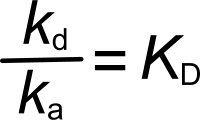
Is the equilibrium dissociation constant all what matters?
In kinetics there seems to be a race for the best (lowest in this context) equilibrium dissociation constant (KD) there is. Interactions are compared by their equilibrium dissociation constant and that is it. Similarly often only the IC50 of a system is given while the full kinetics are not well established.
In my opinion, reporting a single value for a kinetic interaction is hiding all the other information present in the measurements between two or more components.
In my opinion, reporting a single value for a kinetic interaction is hiding all the other information present in the measurements between two or more components.

Improving protein quality
With regular maintenance your instrument is in perfect order. In addition you make the best, clean and degassed buffers. But what about the proteins you use? Are they of the best quality? And this new batch is the same as the previous, you are sure of that?
Is your protein affected by the buffer and immobilization conditions used? Your assay problems might be caused by poor protein quality!
Luckily there is an easy and fast way to check the integrity of your proteins. Nanotemper Technologies provides various instruments to check your protein quality, all using a minimum of sample. .
Is your protein affected by the buffer and immobilization conditions used? Your assay problems might be caused by poor protein quality!
Luckily there is an easy and fast way to check the integrity of your proteins. Nanotemper Technologies provides various instruments to check your protein quality, all using a minimum of sample. .

SPR is not an Art!
Surface Plasmon Resonance (SPR) seems to be difficult for many people. Judging on the literature many of you are struggling to get nice sensorgrams with easy to fit curves. However, SPR is straightforward when you know what you are doing. Consequently, you have to learn how SPR works, how to perform an experiment and how to analyze it. So what are the key parts of a proper SPR experiment?
Blog of Ryan Denomme
Ryan Denomme of Nicoya publishes a nice blog about SPR and related topics. For instance about preserving precious sample by optimizing preconcentration and immobilization or what the difference is between SPR and LSPR.
Definitely worthwhile to check this blog!

How Low Can You Go ?
In SPR experiments, low responses are preferred over high responses. This is because high responses in general are affected by mass transport and non 1:1 interactions. But how low can you go?
This depends in the first place on the instrument you have chosen. The signal should be above the noise level of the baseline. The curves should be easily recognisable and replicates should overlay.
This depends in the first place on the instrument you have chosen. The signal should be above the noise level of the baseline. The curves should be easily recognisable and replicates should overlay.

25 Years Of SPR
Although the phenomenon of surface plasmon resonance (SPR) was known for a long time (see Wood; 1902), in 1990 Pharmacia Biosensor AB brought the first commercial SPR instrument to the market. For a long time, these so-called Biacore instruments set the standard in research using SPR. Nowadays we say that we do a Biacore experiment when we mean that we do a SPR experiment. Since then, the instruments have been evolved and several new manufacturers are selling SPR instruments with new features (SPR imaging: IBIS; Interaction Array: Bio-Rad; multi-parametric SPR: BioNavis ), new sensor chip types (alginate surface: Bio-Rad; hydrophilic SAM: Xantec; graphene surface: Sensia) and software wizards to guide the user.
The instruments are all in best shape and performing excellent. However, how is the user doing? Has he also developed with the instruments or is he struggling to keep up?
The instruments are all in best shape and performing excellent. However, how is the user doing? Has he also developed with the instruments or is he struggling to keep up?